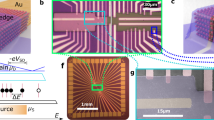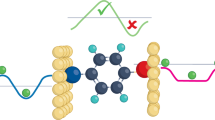Abstract
So-called bottom-up fabrication methods aim to assemble and integrate molecular components exhibiting specific functions into electronic devices that are orders of magnitude smaller than can be fabricated by lithographic techniques. Fundamental to the success of the bottom-up approach is the ability to control electron transport across molecular components. Organic molecules containing redox centres—chemical species whose oxidation number, and hence electronic structure, can be changed reversibly—support resonant tunnelling1,2 and display promising functional behaviour when sandwiched as molecular layers between electrical contacts3,4, but their integration into more complex assemblies remains challenging. For this reason, functionalized metal nanoparticles have attracted much interest5,6,7: they exhibit single-electron characteristics8,9,10 (such as quantized capacitance charging) and can be organized11,12,13 through simple self-assembly methods into well ordered structures, with the nanoparticles at controlled locations. Here we report scanning tunnelling microscopy measurements showing that organic molecules containing redox centres can be used to attach metal nanoparticles to electrode surfaces and so control the electron transport between them. Our system consists of gold nanoclusters a few nanometres across and functionalized with polymethylene chains that carry a central, reversibly reducible bipyridinium moiety14,15. We expect that the ability to electronically contact metal nanoparticles via redox-active molecules, and to alter profoundly their tunnelling properties by charge injection into these molecules, can form the basis for a range of nanoscale electronic switches.
This is a preview of subscription content, access via your institution
Access options
Subscribe to this journal
Receive 51 print issues and online access
$199.00 per year
only $3.90 per issue
Buy this article
- Purchase on Springer Link
- Instant access to full article PDF
Prices may be subject to local taxes which are calculated during checkout




Similar content being viewed by others
References
Tao, N. J. Probing potential-tuned resonant tunneling through redox molecules with scanning tunneling microscopy. Phys. Rev. Lett. 76, 4066–4069 (1996).
Han, W. H. et al. STM contrast, electron-transfer chemistry, and conduction in molecules. J. Phys. Chem. B 101, 10719– 10725 (1997).
Feldheim, D. L. & Keating, C. D. Self-assembly of single electron transistors and related devices. Chem. Soc. Rev. 27, 1–12 ( 1998).
Chen, J., Reed, M. A., Rawlett, A. M. & Tour, J. M. Large on-off ratios and negative differential resistance in a molecular electronic device. Science 286, 1550– 1552 (1999).
Ashoori, R. C. Electrons in artificial atoms. Nature 379, 413–419 (1996).
Collier, C. P., Saykally, R. J., Shiang, J. J., Henrichs, S. E. & Heath, J. R. Reversible tuning of silver quantum dot monolayers through the metal-insulator transition. Science 277, 1978–1981 ( 1997).
Oosterkamp, T. H. et al. Microwave spectroscopy of a quantum-dot molecule. Nature 395, 873–876 ( 1998).
Chen, S. W. & Murray, R. W. Electrochemical quantized capacitance charging of surface ensembles of gold nanoparticles. J. Phys. Chem. B 103, 9996–10000 ( 1999).
Ingram, R. S. et al. 28 kDa alkanethiolate protected Au clusters give analogous solution electrochemistry and STM coloumb staircases. J. Am. Chem. Soc. 119, 9279–9280 ( 1997).
Andres, R. P. et al. “Coulomb staircase” at room temperature in a self-assembled molecular nanostructure. Science 272, 1323 –1325 (1996).
Kiely, C. J., Fink, J., Brust, M., Bethell, D. & Schiffrin, D. J. Spontaneous ordering of bimodal ensembles of nanoscopic gold clusters. Nature 396, 444– 446 (1998).
Schmid, G. Clusters and Colloids (VCH, Weinheim, 1994).
Templeton, A. C., Wuelfing, M. P. & Murray, R. W. Monolayer protected cluster molecules. Acc. Chem. Res. 33, 27–36 (2000).
Gittins, D. I., Bethell, D., Nichols, R. J. & Schiffrin, D. J. Diode-like electron transfer across nanostructured films containing a redox ligand. J. Mater. Chem. 10, 79– 83 (2000).
Gittins, D. I., Bethell, D., Nichols, R. J. & Schiffrin, D. J. Redox-connected multilayers of discrete gold particles: A novel electroactive nanomaterial. Adv. Mater. 11, 737– 740 (1999).
Chen, C. J. Introduction to Scanning Tunneling Microscopy (Oxford Univ. Press, New York, 1993).
Joachim, C., Gimzewski, J. K., Schlittler, R. R. & Chavy, C. Electronic transparency of a single C60 molecule. Phys. Rev. Lett. 74, 2102–2105 (1995).
Yazdani, A., Eigler, D. M. & Lang, N. D. Off-resonance conduction through atomic wires. Science 272, 1921–1924 ( 1996).
Friis, E. P. et al. An approach to long-range electron transfer mechanisms in metalloproteins: In situ scanning tunneling microscopy with submolecular resolution. Proc. Natl Acad. Sci. USA 96, 1379– 1384 (1999).
Vaught, A., Jing, T. W. & Lindsay, S. M. Non-exponential tunneling in water near an electrode. Chem. Phys. Lett. 236, 306– 310 (1995).
DeLong, H. C. & Buttry, D. A. Environmental effects on redox potentials of viologen groups embedded in an electroactive SAM. Langmuir 8, 2491–2496 ( 1992).
Brust, M., Bethell, D., Schiffrin, D. J. & Kiely, C. J. Novel gold-dithiol nano-networks with nonmetallic electronic properties. Adv. Mater. 7, 795–797 ( 1995).
Bethell, D., Brust, M., Schiffrin, D. J. & Kiely, C. From monolayers to nanostructured materials - an organic chemist's view of self-assembly. J. Electroanal. Chem. 409, 137–143 (1996).
Ulman, A. An Introduction to Ultrathin Organic Films (Academic, San Diego, 1991).
Acknowledgements
This work was supported by the UK EPSRC Scanning Probe Microscopy initiative. D.I.G thanks EPRSC for the award of a quota studentship. D.B. thanks the Leverhume Trust for the award of an Emeratus Fellowship.
Author information
Authors and Affiliations
Corresponding author
Rights and permissions
About this article
Cite this article
Gittins, D., Bethell, D., Schiffrin, D. et al. A nanometre-scale electronic switch consisting of a metal cluster and redox-addressable groups. Nature 408, 67–69 (2000). https://doi.org/10.1038/35040518
Received:
Accepted:
Issue Date:
DOI: https://doi.org/10.1038/35040518
This article is cited by
-
Biogenic metallic nanoparticles as game-changers in targeted cancer therapy: recent innovations and prospects
Future Journal of Pharmaceutical Sciences (2024)
-
Single-cluster electronics using metallic clusters: Fabrications, regulations, and applications
Nano Research (2024)
-
Two-step Laser Ablation in Liquid-assisted Magnetic Fields for Synthesis Au:Pb Core/Shell NPs in Developing High-Performance Silicon-based Heterojunction Photodetector
Plasmonics (2024)
-
A novel laser-assisted approach for synthesis of AuNPs/PS nanostructures as photodetector
Journal of Optics (2023)
-
Mechanism of rectification and negative differential resistance in single-molecule junctions with asymmetric anchoring groups: a DFT study
Journal of Molecular Modeling (2023)
Comments
By submitting a comment you agree to abide by our Terms and Community Guidelines. If you find something abusive or that does not comply with our terms or guidelines please flag it as inappropriate.



